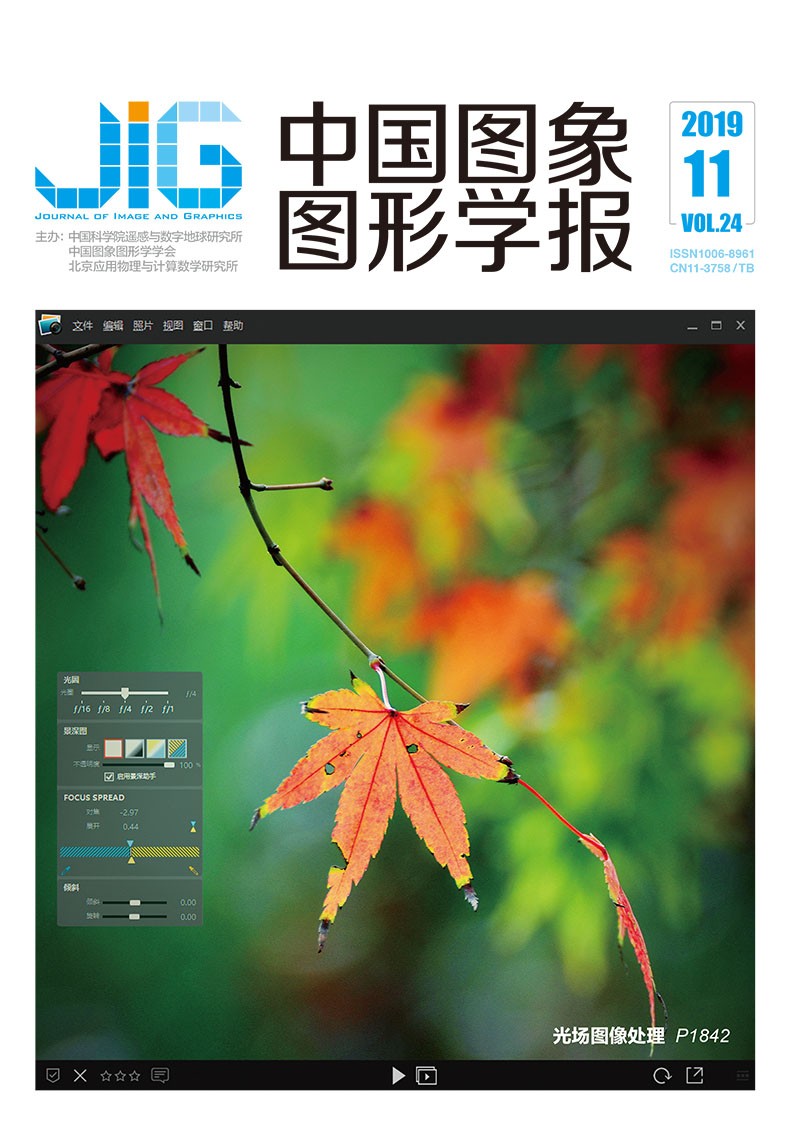
理想投影椭圆约束下的鱼眼镜头内部参数标定
摘 要
目的 鱼眼镜头是发展轻、小型全方位视觉系统的理想光学传感器,但由于镜头焦距短、视场大及光学原理约束,鱼眼图像存在严重畸变,为此提出一种高精度、应用方式灵活的鱼眼镜头内部参数标定方法,以期将鱼眼图像转换成符合人眼视觉习惯的平面透视投影图像。方法 从球面透视投影模型出发,首先分析给出空间直线在水平面上的理想投影椭圆约束,进而结合椭圆严格几何特性建立误差方程对鱼眼相机等效焦距f,纵横比A及径向畸变参数k1,k2进行最小二乘估计,最后利用估计参数对鱼眼图像进行立方盒展开实现平面透视纠正目的。结果 对某型号定焦鱼眼相机的棋盘格影像多视标定及网上鱼眼图像单视自标定结果表明,本文方法标定参数对鱼眼图像不同区域的平面透视纠正效果稳健、精度高。多视标定参数均方根误差(RMSE)约0.1像素,纠正影像上直线拟合误差RMSE约0.2像素,总体效果略优于对比文献方法;单视自标定参数误差RMSE约0.3像素,影像纠正范围、直线透视特性保持明显优于对比文献方法及商业软件DXO(DXO Optics Pro)。结论 本文方法标定参数少、计算过程简单且对标定参照物要求不高,对于具有大量直线的人工场景理论上可实现自标定,应用价值较高。
关键词
Fish-eye lens calibration by ideal projection ellipse constraints
Huang Mingyi, Wu Jun(School of Electronic Engineering and Automation, Guilin University of Electronic Technology, Guilin 541004, China) Abstract
Objective Fish-eye lens is an ideal optical sensor to develop light and small omnidirectional vision systems. Due to the characteristics of large field of view and low cost, it is widely used in various places such as security monitoring. Based on a large number of original fisheye video materials, it has the potential for in-depth research and full exploitation. Therefore, the calibration of fisheye cameras needs to obtain the internal parameters of the images. How to improve the indoor and outdoor aspects of the city is imperative. The calibration efficiency of model fisheye camera is a valuable and challenging research work. However, due to the limitation of short focal length, large field of view and special optical principle, fish-eye images will produce serious barrel distortion, which is not conducive to the subsequent development and application of video images. Constraints of optical principle it is expected to be transformed into plane perspective projection, which conforms to human visual habits, by a set of high-precision parameters associated with the optical imaging model of the fish-eye lens. To this end, a high-precision and flexible method for calibrating the internal parameters of fish-eye lens is proposed in this study. Method The calibration is achieved through the following steps: Firstly, we need to obtain the initial internal parameters of fisheye image. According to the principle that the spatial line is imaged as an elliptic curve on the image, we extract the image elliptic curve. The specific methods are as follows: a) obtain the coordinates of the curve points on the image by image segmentation, b) obtain the general curve equation of the ellipse by curve fitting, than decompose the general equation into the ellipse long and short axis length and image principal point used as initial value. Secondly, ideal projection ellipse constraints (IPECs) for any space line on the horizontal plane under spherical perspective projection are mathematically set. The constraints are as follows: a) the half length of the long axis of projection ellipse of different space straight lines is constantly equal to the radius of the projection sphere; and b) the length ratio of long axis to short axis of the projection ellipse is constant for any one space line when the radius of the projection sphere is changed. Thirdly, a nonlinear function is built on the basis of the proposed IPECs and the strict geometric properties of ellipses to conduct an iterative least square estimation for the uncalibrated fish-eye lens parameters, namely, focal length f, aspect ratio A, and distortion parameters k1, k 2. Finally, the distorted fish-eye images are corrected by using the estimated lens parameters and cube-box expansion. Result One focus-fixed fish-eye camera is selected to test the proposed approach under multiple-view condition. In addition, several parameter-free fish-eye images downloaded from the Internet are selected to test the proposed approach under single-view condition. Experimental results show that stable and high-quality correction is achieved in different areas of fish-eye images by using the estimated calibration parameters. The root-mean-square error (RMSE) in multiple-view calibration for the selected fish-eye camera is approximately 0.1 pixel, and the straight-line fitness RMSE in the corrected fish-eye image is only approximately 0.2 pixel. These results are slightly better than the results produced by an online calibration toolbox. Compared with our method in which only a small number of lens internal parameters needed to be solved directly, the online calibration toolbox is more complex in model characterization and estimation calculation, in which two additional radial distortion parameters k3 and k4 are added to characterize the internal parameters of fish-eye lens. The external parameters of the camera are also required for simultaneous estimation. Although our method uses the straight line features on a chessboard, no requirement is set for its spatial (physical) accuracy (position and direction). By contrast, the online calibration toolbox depends fundamentally on the interposition accuracy of a chessboard’s corner points; multiple photographs of a small-sized chessboard at a specific angle are often required for ideal control conditions because photographs of a large-sized chessboard with high accuracy are difficult to obtain. The single-view calibration RMSE is approximately 0.3 pixel, and its straight-line geometry preservation on corrected fish-eye images is obviously better than the results produced by popular commercial software DXO toolbox. Conclusion The proposed calibration can be realized with few calibration parameters and a simple calculation that allows it to be implemented via self-calibration for artificial scenes with a large number of lines. This characteristic makes the calibration useful in applications such as panorama surveillance, 3D reconstruction, and robot navigation.
Keywords
fish-eye lens calibration fish-eye camera calibration fish-eye image correction spherical perspective projection ideal projection ellipse constraint
|



 中国图象图形学报 │ 京ICP备05080539号-4 │ 本系统由
中国图象图形学报 │ 京ICP备05080539号-4 │ 本系统由